DNA as Drug Targets
1/28
There's no tags or description
Looks like no tags are added yet.
Name | Mastery | Learn | Test | Matching | Spaced |
|---|
No study sessions yet.
29 Terms
True or false: DNA acts as a receptor, but DNA-targeting drugs are generally very toxic so they are not used except for life-threatening diseases.
False. DNA does not act as a receptor. It carries genetic information in cells, but DNA-targeting drugs are very toxic.
Which of the following is NOT a characteristic of DNA-interactive drugs?
What do these properties describe?
a. Activation of proteins (i.e. p53) in normal cells that respond to cell damage. There is an increase DNA repair enzymes, cell cycle arrest (for time for DNA to repair) and programmed cell death (apoptosis).
b. Their repair mechanisms are too slow.
c. They stimulate rapid DNA synthesis to override the cell to encourage apoptosis.
d. It is rapidly up taken by cancer cells.
These properties demonstrate that DNA-interactive drugs are toxic.
c. They stimulate rapid DNA synthesis to override the cell to encourage apoptosis.
Match the Classes of DNA-Interactive Drugs to its definition
This class has reversible interactions with DNA.
a. Reversible binders
b. Alkylators
c. Topoisomerase inhibitors
d. Strand breakers
a. Reversible binders
Match the Classes of DNA-Interactive Drugs to its definition
This class reacts covalently with DNA bases.
a. Reversible binders
b. Alkylators
c. Topoisomerase inhibitors
d. Strand breakers
b. Alkylators
Match the Classes of DNA-Interactive Drugs to its definition
This class prevents the relaxation of superhelical DNA.
a. Reversible binders
b. Alkylators
c. Topoisomerase inhibitors
d. Strand breakers
c. Topoisomerase inhibitors
Match the Classes of DNA-Interactive Drugs to its definition
This class generates reactive radicals that cleave polynucleotide strands.
a. Reversible binders
b. Alkylators
c. Topoisomerase inhibitors
d. Strand breakers
d. Strand breakers
Which is NOT one of the effects of combination chemotherapy in comparison to a single drug?
a. Some covalent modifications can be reversed by repair enzymes, so inhibitors of DNA repair can be added to the therapy.
b. It is less toxic than a single drug.
c. It is very effective since there are different mechanisms of actions.
d. It is able to fight acquired resistance unlike single drugs.
b. It is less toxic than a single drug.
The challenge with DNA-Interacting drugs (i.e. chemotherapy) is achieving selectivity (hard to construct a drug that only targets the desired cells vs normal cells)
Where do DNA-interacting drugs specifically target DNA?
a. The grooves on DNA (Major and Minor)
b. Backbone of DNA
c. Individual nucleotides
d. Topoisomerases
a. The grooves on DNA (Major and Minor)
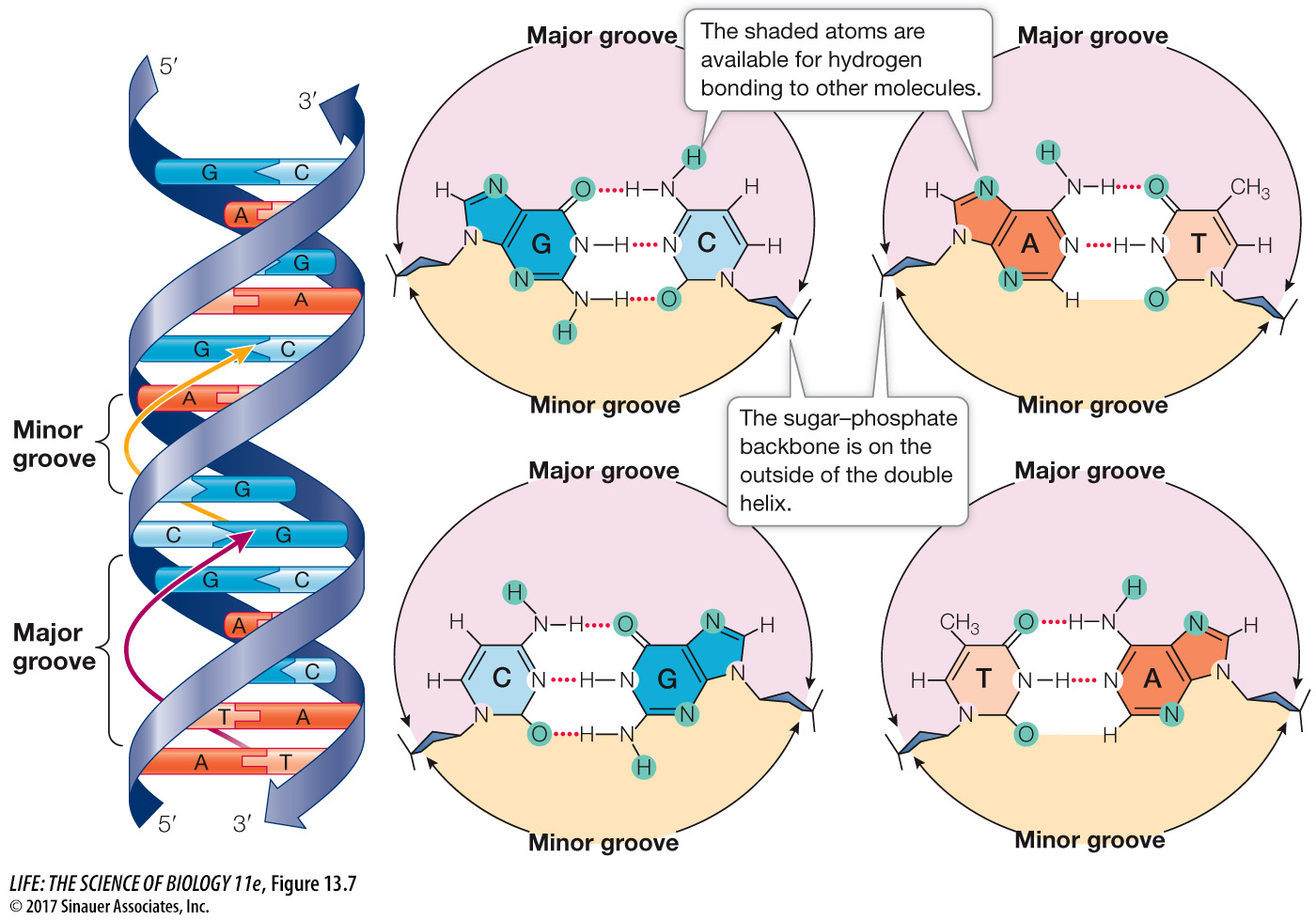
Important for recognition and binding.
DNA-Interacting drugs frequently bind to DNA grooves. Which of the following is FALSE about DNA grooves?
a. They have very distinct geometrical and chemical characteristics.
b. Ligands (drugs) have poor specificity to which groove they bind to, but they have a strong sequence specificity.
c. Major grooves are deep and wide (24Å), rich with basic atoms; this site is more sequence specific.
d. Minor grooves are deep and narrow (10Å); this site is less sequence specific and shapes complementation. They have hydrophobic H atoms of ribose.
b. Ligands (drugs) have poor specificity to which groove they bind to, but they have a strong sequence specificity.
Ligands have HIGH specificity to which groove they bind to, they typically have a LOW sequence specificity (Minor groove).

For Reversible DNA binders, there are 3 ways that SMALL molecules can reversibly bind to DNA. Select the correct 3 ways.
a. Minor groove binder (shapes complementarity + HB)
b. Intercalator pi-Stacking + HB
c. Destabilization
d. External electrostatic coulombic forces (to the ribose of DNA)
e. Strand Scission
a. Minor groove binder (shapes complementarity + HB)
b. Intercalator pi-Stacking + HB
d. External electrostatic coulombic forces

Which way does cis-platin, an anticancer agent used in various cancer treatments, bind to DNA?

a. Minor groove binder
b. Intercalator Pi-stacking
c. External electrostatic coulombic forces
c. External electrostatic coulombic forces
covalently bindsd
Which way is Netropsin, a peptide analog that is antibiotic against + and - bacteria, binds to DNA?
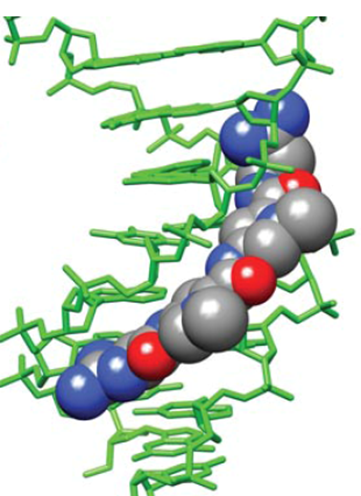
a. Minor groove binder
b. Intercalator Pi-stacking
c. External electrostatic coulombic forces
a. Minor groove binder
binds to 4 consecutive bases mainly through H bonding
displaces H2O molecules that are usually bound there
Which way is Dynemycin, an anticancer drug, binds to DNA?

a. Minor groove binder
b. Intercalator Pi-stacking
c. External electrostatic coulombic forces
b. Intercalator Pi-stacking
True or false: In major groove binding, most of the time there is no or small effect on DNA structure like C2 repressors. However, there are some that produce major distortions, such as the TATA-binding protein.
True! Major groove bindings mainly involve repressor proteins.
Each binding process required a specific type of ligand. Match the type of binding process to the correct ligand.
Ligand is a long, planar crescent-shaped molecule with a mixture of hydrophobic and HB residues.
a. Major groove binding
b. Minor groove binding
c. Intercalator pi stacking
d. External electrostatic coulombic forces
b. Minor groove binding
Example: Methylproamine

Each binding process required a specific type of ligand. Match the type of binding process to the correct ligand.
Ligand is a hydrophilic protein-type (large-sized) molecule.
a. Major groove binding
b. Minor groove binding
c. Intercalator pi stacking
d. External electrostatic coulombic forces
a. Major groove binding
Each binding process required a specific type of ligand. Match the type of binding process to the correct ligand.
Ligand is a fused aromatic ring also equipped with HB residues.
a. Major groove binding
b. Minor groove binding
c. Intercalator pi stacking
d. External electrostatic coulombic forces
c. Intercalator pi stacking
Hint: pi stacking involves the overlapping of 2 aromatic rings!
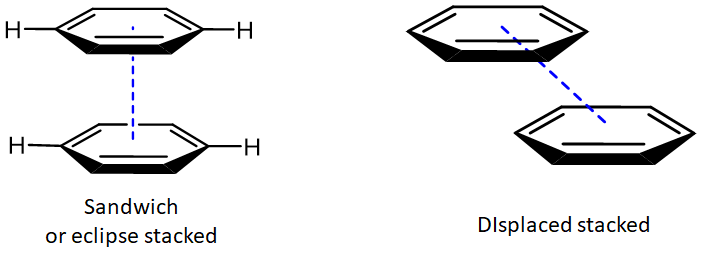
Each binding process required a specific type of ligand. Match the type of binding process to the correct ligand.
Ligand is a long molecule with HIGH positive (+) charge.
a. Major groove binding
b. Minor groove binding
c. Intercalator pi stacking
d. External electrostatic coulombic forces
d. External electrostatic coulombic forces
Which of the following is FALSE about Minor Groove Binders?
a. They are long, planar, crescent-shaped molecules.
b. Hydrophobic, but they still have the capacity to form HBs with DNA bases.
c. Mind to mostly AT-rich sequences at narrower minor groove areas.
d. Only binds irreversibly to DNA.
d. Only binds irreversibly to DNA.
Minor groove binding is one of the 3 reversible ways small molecules bind to DNA.
can still form covalent irreversible bonds i.e. alkylation of bases —> duocarmycins

Shown above is the MOA of Alkylating drugs. Please explain each step of this example.
Nitrogen in a mustard (molecule with N or S bonded by two —CH2CH2X FGs X= Cl or Br) is very nucleophilic and kicks out the Cl atom.
Forms an Aziridinium cation, which allows the first Nucleophile to attack.
Nitrogen becomes nucleophilic again and kicks out the other Cl atom.
Another aziridinium cation forms, attracting the second nucleophile to attack

True or false: Some mustards always have a nucleophilic central atom (S or N).
False! Some mustards have a non-nucleophilic nitrogen —> metabolically activated.
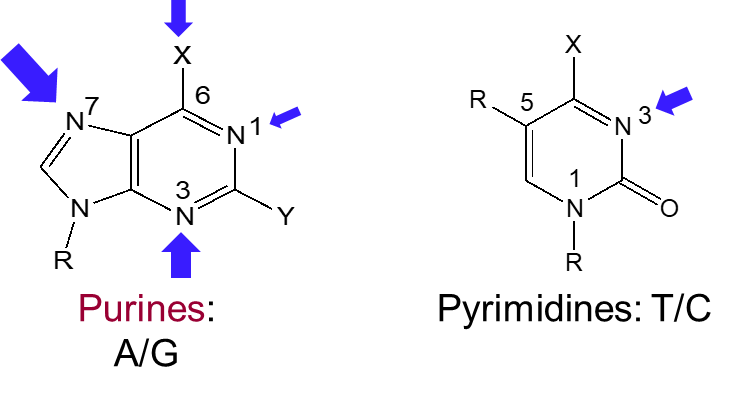
Shown above is the backbone of purines (A + G) and Pyrimidines.
Choose the correct ranking of nucleophilic sites by their likelihood/reactivity toward alkylation.
a. N-1 of Cytosine > N-1 of Adenine > N-3 of Guanine > N-7 of Adenine > N-3 of Adenine > N-7 Guanine
b. N-1 Adenine > N-1 Cytosine > N-7 Adenine > N-3 Guanine > N-3 Adenine > N-7 Guanine
c. N-7 Guanine > N-1 Cytosine > N-1 Adenine > N-3 Guanine > N-3 Adenine > N-7 Adenine
d. N-7 Guanine > N-3 Adenine > N-7 Adenine > N-3 Guanine > N-1 Adenine > N-1 Cytosine
d. N-7 Guanine > N-3 Adenine > N-7 Adenine > N-3 Guanine > N-1 Adenine > N-1 Cytosine
which atoms are best positioned and most reactive to attack the aziridinium ion that is formed
GAAGAC (7,3,7,3,1,1)
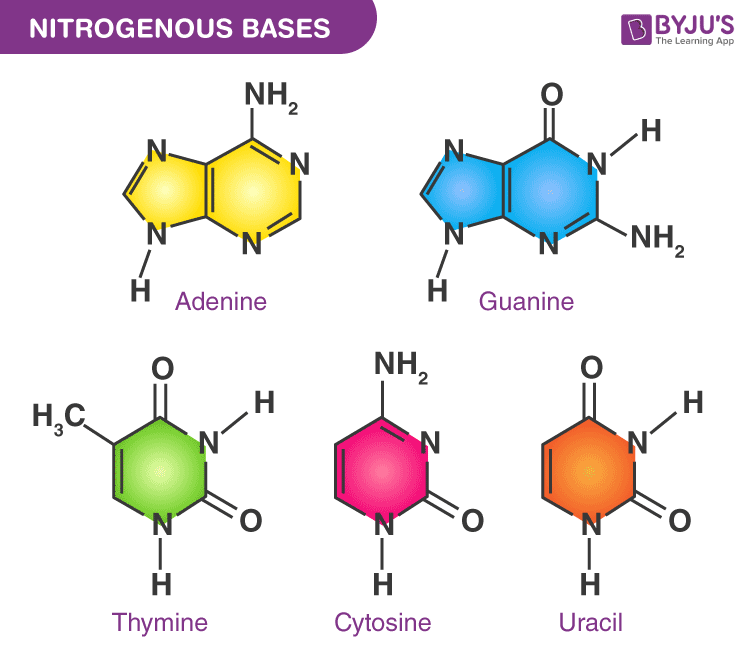
Explain how DNA Alkylation leads to the eliminative cleavage of the DNA strands.
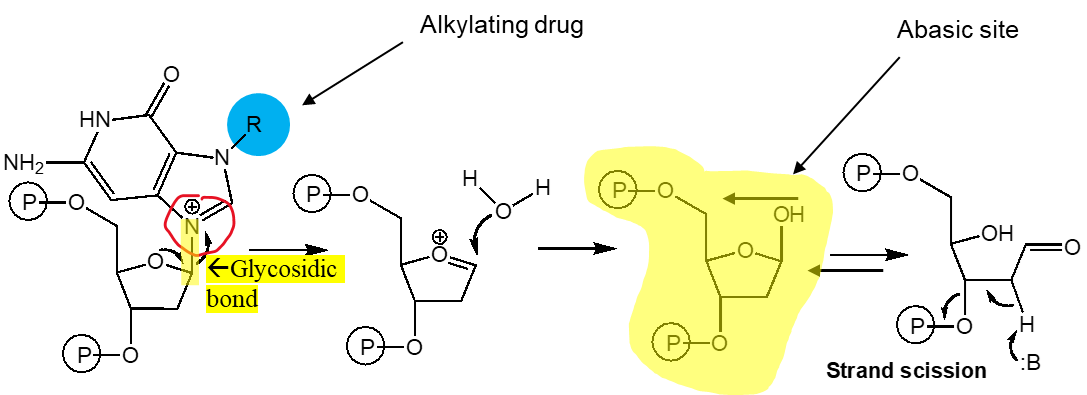
Alkylation of the N-7 of Guanine (in red) destabilizes the glycosidic bond between the Guanine and Deoxyribose residue.
Water binds to the deoxyribose residue
The modification results in DNA depurination: Formation of an Abasic site (loses nucleobase completely)
triggers DNA repair; if it does not occur —> apoptosis
Strand scission occurs —> DNA strands get cleaved at the phospho-ester bonds
True or false: Alkylation can result in carcinogenesis, specifically in cases where a guanine residue can form a bond with an alkylated bond with a Tyrosine instead of a Cytosine.
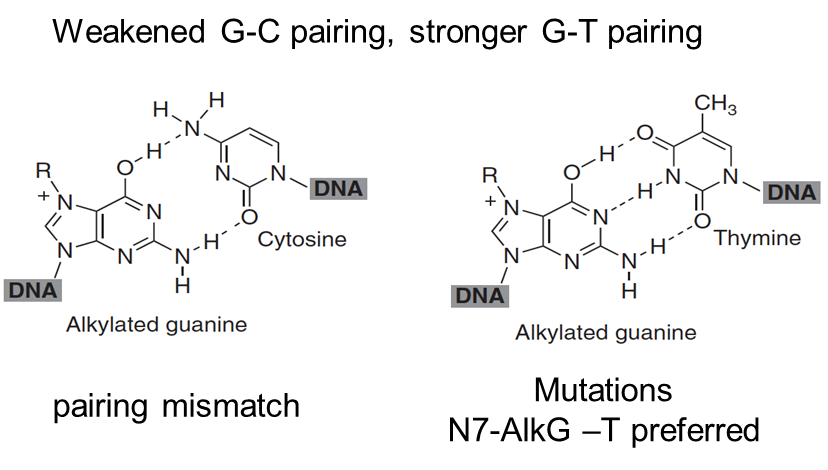
True!
Binding with Cytosine is preferred —> weak
True or false: These are examples of DNA Alkylators!

True!
component used in cancer chemotherapy
nonselective and very toxic —> low therapeutic index
Describe the MOA of Platinum Anticancer drugs (covalent bonding)
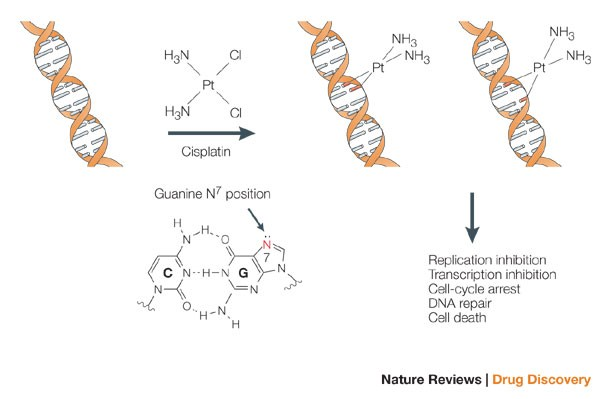
Cisplatin (or other Covalent PLATinum-Based Drugs) covalently binds to dGpG-N7 nitrogens —> intra-strand crosslink (distortion)
Transcription gets inhibited or apoptosis occurs due to the DNA crosslink (disruption)
RNA polymerase stalls at the platinum crosslink
Bonds to the platinum drug cannot be toxic or too strong
True or false: These are examples of Topoisomerase Inhibitors.

False! They are platinum-based anticancer drugs
-platin
DNA supercoiling is when the DNA strand is overwound/underwound during replication and transcription. What role do Topoisomerases play with DNA supercoiling?
They are enzymes that relieve supercoiling by cutting the DNA strand
Tyr-OH attacks phosphate —> Cuts DNA —> covalent bond formed between enzyme & DNA
DNA rotates or passes through —> relieves supercoil
5’—OH of DNA attacks phosphate —> DNA is rejoined and enzyme is released

Which is FALSE about Topoisomerase inhibitors?

a. Topoisomerase inhibitors are DNA intercalators but are able to stabilize the topo-DNA complex as well (this makes it effective enough to fight cancer).
b. Every intercalator is an anti-cancer drug!
c. Topoisomerase forms covalent bonds with DNA
d. Topoisomerases action enable cancer cell division
e. The cleavable complex cannot be re-ligated due to conformational change imposed on Topo by an inhibitor.
b. Every intercalator is an anti-cancer drug!
FALSE!! Intercalator must be able to STABILIZE the cleavable topo-DNA complex.